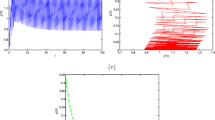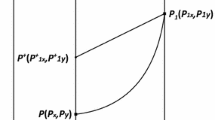Abstract
In this paper, a model is proposed for the biological control of a pest by its natural predator. The model incorporates a qualitative description of intrapredatory interference whereby predator density decreases the per capita predation efficiency and generalises the classical Beddington–DeAngelis formulation. A pair of coupled ordinary differential equations are used, augmented by a discrete component to depict the periodic release of a fixed number of predators into the system. This number is defined in terms of the rate of predator release and the frequency at which the releases are to be carried out. This formulation allows us to compare different biological control strategies in terms of release size and frequency that involve the same overall number of predators. The stability properties of the zero-pest solution are analysed. We obtain an upper bound on the interference strength (the biological condition) and a minimal bound on the predator release rate (the managerial condition) required to eradicate a pest population. We demonstrate that increasing the frequency of releases reduces this minimal rate and also increases the rate of convergence of the system to the zero-pest solution for a given release rate. Additionally, we show that other conclusions are to be expected if the interferences between predators have weaker or stronger effects than the generalised Beddington–DeAngelis formulation proposed in this paper.
Similar content being viewed by others
References
Arditi, R., Ginzburg, L.R., 1989. Coupling in predator-prey dynamics: ratio-dependence. J. Theor. Biol. 139, 311–326.
Beddington, J.R., 1975. Mutual interference between parasites or predators and its effect on searching efficiency. J. Anim. Ecol. 44, 331–340.
Buffoni, G., Gilioli, G., 2003. A lumped parameter model for acarine predator-prey population interactions. Ecol. Model. 170(2–3), 155–171.
Buffoni, G., Cassinari, M.P., Groppi, M., Serluca, M., 2005. Modelling of predator-prey trophic interactions. Part I: two trophic levels. J. Math. Biol. 50, 713–732.
Byers, A., Giovannucci, D., Liu, P., 2008. Value adding standards in the North American food market. trade opportunities in certified products for developing countries. Commodities and Trade Technical paper 11, FAO Trade and Markets Division, Rome.
Damon, A., 2000. Evaluation of current techniques and new approaches in the use of Cephalonomia stephanoderis (Hymenoptera: Bethylidae) as a biological control agent of the coffee berry borer, Hypothenemus hampei (Coleoptera: Scolytidae), in Chiapas, Mexico. Ph.D. Thesis, University of London.
Damon, A., Valle, J., 2002. Comparison of two release techniques for the use of Cephalonomia stephanoderis (Hymenoptera: Bethylidae), to control the coffee berry borer Hypothenemus hampei (Coleoptera: Scolytidae) in Soconusco, southeastern Mexico. Biol. Control 24, 117–127.
DeAngelis, D.L., Goldstein, R.A., O’Neill, R.V., 1975. A model for trophic interaction. Ecology 56, 881–892.
Duan, Z.S., Wang, J.Z., Chen, G.R., Huang, L., 2008. Stability analysis and decentralized control of a class of complex dynamical networks. Automatica 44(4), 1028–1035.
Eskola, H.T.M., Geritz, S.A.H., 2007. On the mechanistic derivation of various discrete-time population models. Bull. Math. Biol. 69(1), 329–346.
Everleigh, E.S., Chant, D.A., 1982. Experimental studies: the effects of predator density on prey consumption, predator searching efficiency, and the functional response to prey density (Acarina: Phytoseiidae). Can. J. Zool. 60, 611–629.
Flowers, R.W., Salom, S.M., Kok, L.T., 2006. Competitive interactions among two specialist predators and a generalist predator of hemlock woolly adelgid, Adelges tsugae (Hemiptera: Adelgida) in south-western Virginia. Agric. For. Entomol. 8, 253–262.
Gerson, U., 2007. Intraguild predation and other interactions among acarine biocontrol agents. In: Gerson, U., Smiley, R.L., Ochoa, R. (Eds.), Mites (Acari) for Pest Control, pp. 360–366. Blackwell, Oxford.
Hassell, M.P., Varley, G.C., 1969. New inductive population model for insect parasites and its bearing on biological control. Nature 223, 1133–1137.
Holling, C.S., 1959. Some characteristics of simple types of predation and parasitism. Can. Entomol. 91, 385–398.
Hu, T.S., Huang, B., Lin, Z.L., 2004. Absolute stability with a generalized sector condition. IEEE Trans. Automat. Contr. 50(11), 1872–1877.
Janssen, A., Bruin, J., Jacobs, G., Schraag, R., Sabelis, M.W., 1997. Predators use volatiles to avoid prey patches with conspecifis. J. Anim. Ecol. 66, 223–232.
Khalil, H., 2002. Nonlinear Systems, 3rd edn. Prentice-Hall, New York.
Koen-Alonso, M., 2007. A process-oriented approach to the multispecies functional response. In: Rooney, N., McCann, K.S., Noakes, D.L.G. (Eds.), From Energetics to Ecosystems: The Dynamics and Structure of Ecological Systems, pp. 1–36. Springer, Berlin.
Kuang, Y., Beretta, E., 1998. Global qualitative analysis of a ratio-dependent predator-prey system. J. Math. Biol. 36(4), 389–406.
Lakmeche, A., Arino, O., 2000. Bifurcation of non-trivial periodic solutions of impulsive differential equations arising in chemotherapeutic treatment. Dyn. Contin. Discrete Impuls. Syst. 7(2), 265–287.
Liberzon, M.R., 2006. Essays on the absolute stability theory. Autom. Remote Control 67(10), 1610–1644.
Liu, B., Zhang, Y.J., Chen, L.S., 2005. The dynamical behaviors of a Lotka-Volterra predator-prey model concerning integrated pest management. Nonlinear Anal. Real World Appl. 6(2), 227–243.
Lur’e, A.I., Postnikov, V.N., 1944. On the theory of stability of the controlled systems. Prikl. Mat. Meh. 8(3), 246–248.
Mailleret, L., Grognard, F., 2006. Optimal release policy for prophylactic biological control. In: Positive Systems: Theory and Applications, Lecture Notes in Control and Information Sciences, vol. 341, pp. 89–96. Springer, Berlin.
Mailleret, L., Grognard, F., 2009. Global stability and optimisation of a general impulsive biological control model. Math. Biosci. 221(2), 91–100.
Mailleret, L., Lemesle, V., 2009. A note on semi-discrete modelling in life sciences. Philos. Trans. R. Soc. A 367, 4779–4799.
Nachman, G., 2006. The effects of prey patchiness, predator aggregation and mutual interference on the functional response of Phytoseiulus persimilis feeding on Tetranychus urticae (Acari: Phytoseiidae, Tetranychidae). Exp. App. Acarol. 38, 87–111.
Negi, K., Gakkhar, S., 2007. Dynamics in a Beddington-DeAngelis prey-predator system with impulsive harvesting. Ecol. Model. 206, 421–430.
Nundloll, S., Mailleret, L., Grognard, F., 2008. The effect of partial crop harvest on biological pest control. Rocky Mt. J. Math. 38(5), 1633–1662.
Nundloll, S., Mailleret, L., Grognard, F., 2010. Two models of interfering predators in impulsive biological control. J. Biol. Dyn. 4, 102–114.
Reganold, J.P., Glover, J.D., Andrews, P.K., Hinman, H.R., 2001. Sustainability of three apple production systems. Nature 410, 926–930.
Royama, T., 1992. Analytical Population Dynamics. Chapman and Hall, London.
Ruxton, G.D., Gurney, W.S.C., 1992. Interference and generation cycles. Theor. Popul. Biol. 42, 235–253.
Shulgin, B., Stone, L., Agur, Z., 1998. Pulse vaccination strategy in the sir epidemic model. Bull. Math. Biol. 60, 1123–1148.
Tang, S., Xiao, Y., Chen, R.A., Cheke, L., 2005. Integrated pest management models and their dynamical behaviour. Bull. Math. Biol. 67, 115–135.
Umbanhowar, J., Maron, S., Harrison, J., 2003. Density-dependent foraging behaviours in a parasitoid lead to density-dependent parasitism of its host. Oecologia 137, 123–130.
Vidyasagar, M.M., 1993. Nonlinear Systems Analysis. Prentice-Hall, New York.
Visser, M.E., Jones, T.H., Driessen, G., 1999. Interference among insect parasitoids: multi-patch experiment. J. Anim. Ecol. 68, 108–120.
Yasuda, H., Takagi, T., Kogi, K., 2000. Effects of conspecific and heterospecific larval tracks on the oviposition behaviour of the predatory ladybird, Harmonia axyridis (Coleoptera: Coccinellidae). Eur. J. Entomol. 97, 551–553.
Zhang, S., Chen, L.S., 2006. A study of predator-prey models with the Beddington-DeAngelis functional response and impulsive effect. Chaos, Solitons Fractals 27, 237–248.
Zhang, H., Georgescu, P., Chen, L.S., 2008. An impulsive predator-prey system with Beddington-DeAngelis functional response and time delay. Int. J. Biomath. 1(1), 1–17.
Author information
Authors and Affiliations
Corresponding author
Rights and permissions
About this article
Cite this article
Nundloll, S., Mailleret, L. & Grognard, F. Influence of Intrapredatory Interferences on Impulsive Biological Control Efficiency. Bull. Math. Biol. 72, 2113–2138 (2010). https://doi.org/10.1007/s11538-010-9531-6
Received:
Accepted:
Published:
Issue Date:
DOI: https://doi.org/10.1007/s11538-010-9531-6




